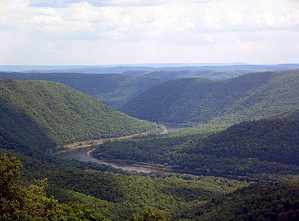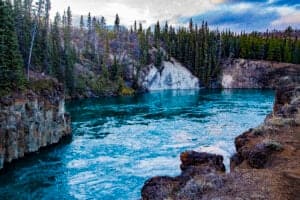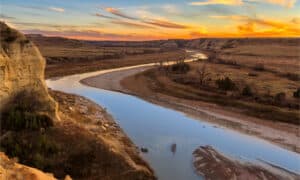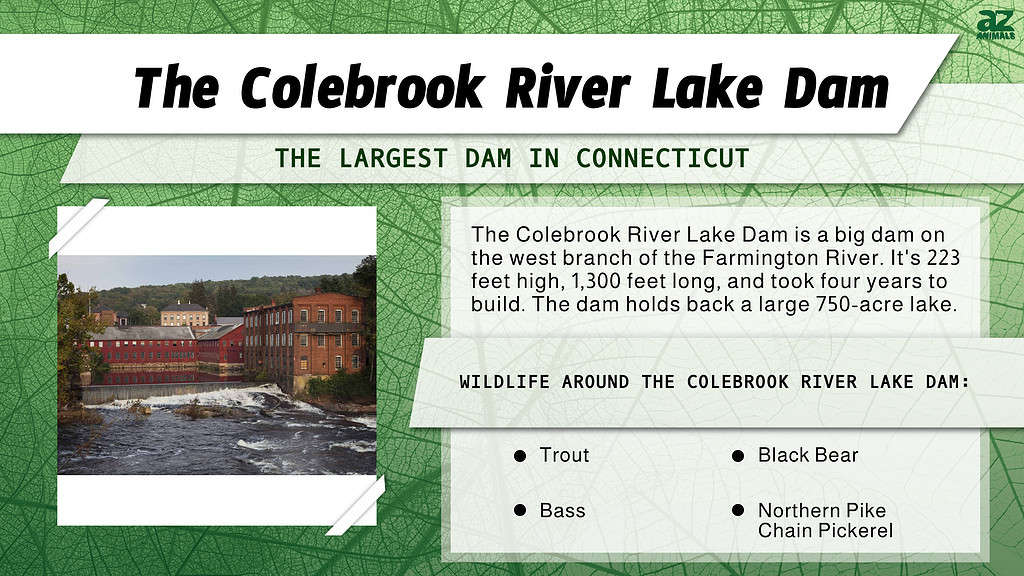
Colebrook, Connecticut, is a quintessential New England small town and its environs resemble a never-ending Norman Rockwell painting, complete with verdant hills, winding back roads, colorful locals, a bevy of black bears, and good fishing.
Yet, there is something outsize in Colebrook — a 223-foot-high behemoth dam located on the west branch of the Farmington River. The structure, which took workers four years to build, is 1,300 feet long and holds back a 750-acre lake.
Despite being one of the smallest states, Connecticut overflows with 5,800 miles of rivers and streams. Some are Lilliputian, such as the Pomperaug River, which meanders through parts of western Connecticut. Others, like the Connecticut, Farmington, Housatonic, and Thames, are significantly larger.
Over the decades, workers built 4,000 dams to stop water from these waterways from flooding towns and cities. While some are quite large, nothing compares to Connecticut’s largest dam — the Colebrook River Lake Dam.
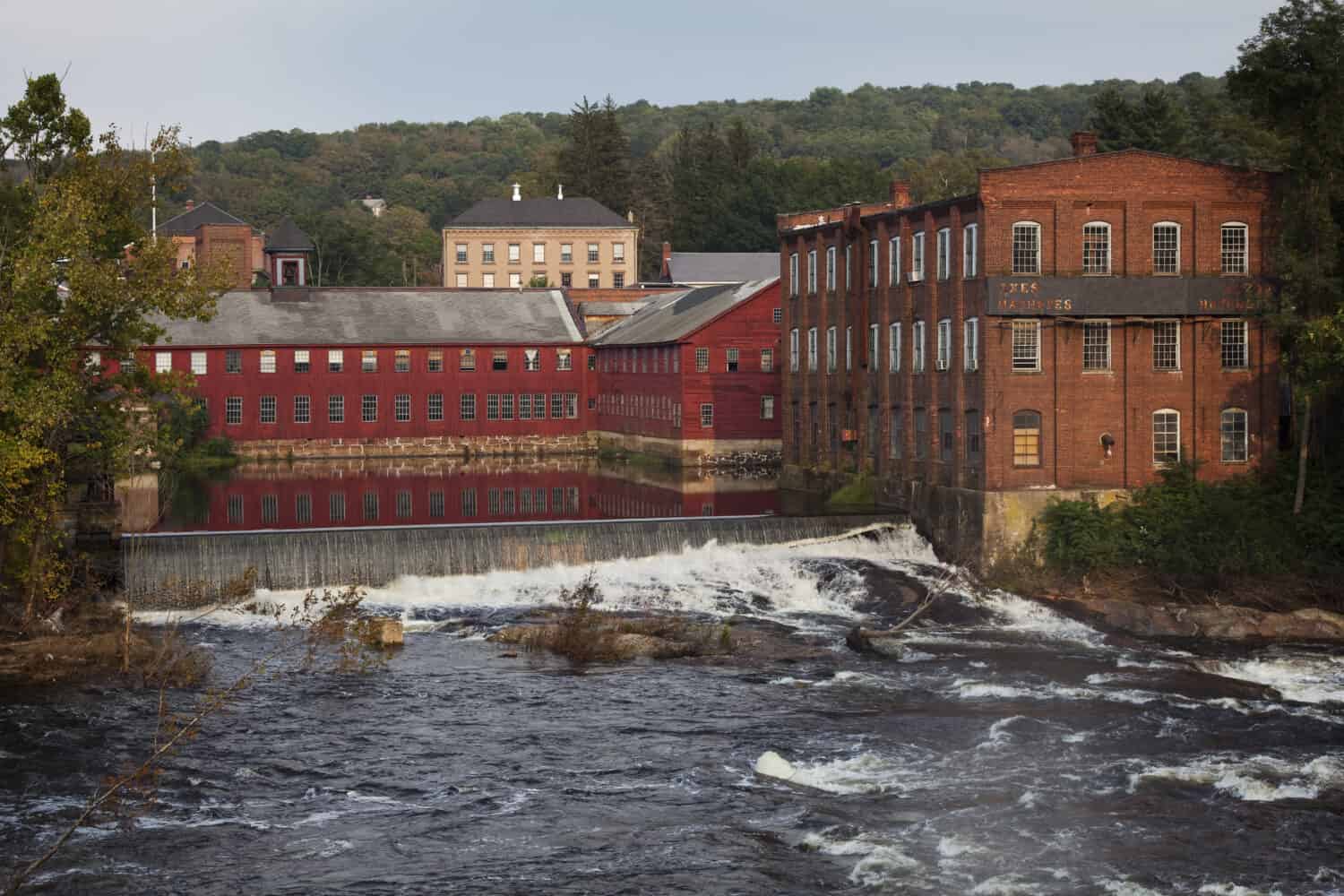
The rushing water of the Farmington River in Connecticut once powered a number of different mills, such as those in Collinsville.
©Jay Petersen/Shutterstock.com
The Wrath of Hurricanes
To understand why engineers built the Colebrook Dam, let’s go back to 1955 when two angry sisters, Connie and Diane, unleashed a fearsome one-two punch that left the state bloodied, battered, and flooded. Connie and Diane were back-to-back hurricanes that cut a violent swath up the East Coast, dumping copious amounts of water from the Carolinas into New England.
Hurricane Connie was the first to strike. She roared to life in early August as a tropical Atlantic storm, crashing ashore as a hurricane on August 12 in North Carolina. Connie followed a northwesterly path ripping through Pennsylvania. While portions of New Jersey and the Keystone State suffered most of Connie’s rage, Southern New England, which includes Connecticut, saw around eight inches of rain.
The Great ’55 Flood
For many in Connecticut, especially farmers, Connie was welcomed relief. It had been a dry summer. Little did anyone know Connie was the first act of a bloody two-act play. She paved the way for a more disastrous hurricane — Diane.
Diane made landfall in North Carolina on August 17. The next day, the storm moved northward across Virginia, made a sharp right turn over Pennsylvania and New Jersey, and headed back toward the Atlantic. As Diane spun, it skirted Long Island and New England’s southern coast, leaving untold devastation in her wake as she unleashed up to 20 inches of rain.
Connie had already saturated the ground, which meant the surrounding landscape could not hold any more water. The result was major flooding across the region. Waterways jumped their banks chiseling out the sides of hills and tearing roadways across Southern New England and New York.
In Connecticut, the Farmington, Housatonic, Shepaug, Naugatuck, and Madd rivers, among others, flooded entire towns and cities. At the headwaters of the Farmington River, Diane deposited 18 inches of rain in 24 hours, a record for New England. The ’55 Flood, as people now remember it, killed 200 people, including 74 in Connecticut.
Holding Back the Water
The destruction wrought by Connie and Diane forced officials to rethink Connecticut’s flood control projects. As a result, workers throughout the 1950s and 1960s built a number of dams. The Colebrook Dam was the largest.
Workers began building the dam in May 1965 and finished in 1969. The price was $14.3 million. The dam itself is earthfill, which means engineers built it using layers of earth and rock.
Community Asset
Over the years, the dam has served the community well. It has substantially reduced flooding on the Farmington River’s west branch and downstream along the Connecticut River. The dam also created an impoundment lake, the level of which can vary wildly.
The lake generally covers 750 acres, yet when full, it can balloon to 1,185, according to the Corp of Engineers. The Corps can regulate the amount of water by lowering or raising three gates. When water levels run high, the gates are lowered. When the water level runs low, the gates are raised.
In addition to minimizing the risk of flooding downstream, Colebrook Lake also serves as a water supply for the Hartford Metropolitan Water District. The lake is also a fisher’s paradise. The lake is dotted with ice fishermen every winter.
Both Massachusetts and Connecticut stock trout and salmon during the spring. Still, many native species like bass, pickerel, perch, and bluegill ply the lake’s water. A number of landlubbing animals, specifically deer, black bears, beavers, and muskrats, among others, live near the dam, as do birds such as herons, snow geese, and ducks.

Black bears are common in the area surrounding the Colebrook River Lake Dam in Connecticut.
©TangoFoxtrot2018/Shutterstock.com
The photo featured at the top of this post is © SevenMaps/Shutterstock.com
Thank you for reading! Have some feedback for us? Contact the AZ Animals editorial team.




